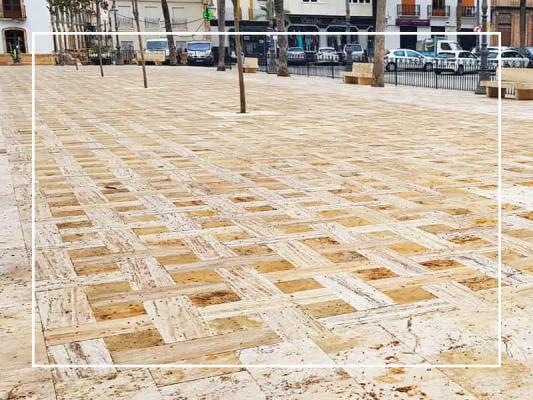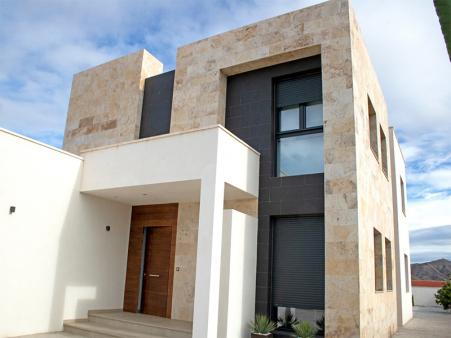Teresa González Díez
The natural stones known as travertines are calcite formations created in the vicinity of springs. Their characteristic holes or cracks have been produced by the bubbles of oxygen in the water. This porous limestone can be found all over the world, but the best known materials are from Turkey and Italy, followed by Peru, Mexico and Iran. The colours are varied: ochre, cream, brown, greenish, reddish, amber and yellow. It is a durable material and very much appreciated by architects for construction, both for exterior and interior elements. It has only one problem: it is very sensitive to acidic substances, so a good sealing is important. This will also facilitate its preservation and maintenance.
Although it is not very well known, there are also travertine quarries in Spain, most of them in the provinces of Almeria, Teruel and Valencia, among others. The most characteristic feature of Spanish travertine is the macro porosity, with the arrangement and sizes of the pores varying greatly. When cut in the direction of the banding, their quality is very good. All of them are used both for exterior and interior use, whether in floor tiles, facades, swimming pools, bathroom countertops, kitchens, columns, fountains and garden and urban furniture.
As always, some materials are called by different names. In this article we are going to name the most sold ones and their production.
TRAVERTINE AL-ÁNDALUS AND TRAVERTINE ROSÉ
Both come from the same quarry that the company Mármoles La Viña has in Alhama, Almería. Its current production is 4 thousand m3/year.
The Travertino Al-Ándalus has soft reddish and honey tones and the Travertino Rosé has a more intense reddish tone, tending to brown. Both have a high resistance to extreme temperatures, so they are very suitable for external use.
Travertino Al-Ándalus:
Travertino Rosé:
OLIVILLO TRAVERTINE
The quarry is located in the municipalities of Alicún and Terque, Almería, it also belongs to the company Mármoles La Viña and its production is 6 thousand m3/year.
It is a material of brownish tones, varying between ochre, beige and grey, with darker and lighter areas. It admits two types of cut: the linear vein and the vein to its thread. It can be left with open pore, very suitable for rustic finishes, or covered with fillings and resins. It admits many textures: bush-hammered, polished, aged, honed and sandblasted.
The main market for these three travertines (Al Ándalus, Rosé and Olivillo) is Spain, but they are also exported to France, Germany, Italy and South America, where the company has its own distributor.
YELLOW TRAVERTINE AND GOLD TRAVERTINE
Yellow travertine and gold travertine are two materials extracted from the same quarry. Yellow in colour and with darker orange and brown tones, the quarries are located in the northern part of Almeria, in Albox, and have been in operation for more than 150 years.
Margar Stone, part of the Travertino Amarillo Group, currently operates three quarries of the same stone. The factory is two kilometres away, which makes processing easier, and its facilities include 1,200 m2 of exhibition space and some 4,000 m2 of warehouses for the transformation of the material.
Initially, Travertino Oro and Travertino Amarillo were used to create the town's infrastructures, such as bridges and retaining walls. One of its projects is still standing today, the retaining wall of the Albox wadi, which was built in 1890, after a flood that cost the lives of hundreds of the town's citizens.
Travertino Amarillo:
Nowadays, the stone from this quarry is used in all types of works, from the commercialisation of marble workshop boards, to its infinite applications, both exterior and interior, in any type of project. Every day it is more and more common to use it for outdoor areas, such as swimming pools, with common areas, stairs, etc. The golden travertine paving, in summer, prevents the temperature from rising, as it does not heat up.Another of the areas where this material is being used the most is in public squares, due to its strength, which also allows the placement of street furniture to accompany the same work.
Travertino Oro:
The application of resin on the piece makes it more versatile when it comes to placing it and easier to manipulate, it is a finish that makes it easier to apply.The textures that can be used are: bush-hammered, honed, aged and polished.
TERUEL TRAVERTINE AND NOCHE TRAVERTINE
The quarries of these two materials belong to the company Mármoles Llorens. The Travertino Teruel quarry is located in Monteagudo, in Villalba Baja and the Travertino Noche quarry is located in Los Baños, in Tortajada, both in Teruel.Between the two materials, there is an annual production of approximately 80,000 m2 of finished material.
Teruel travertine is a natural stone that does not freeze, compact and crystalline, very suitable for outdoors in cold areas. Its colour varies between ochre and grey, depending on the texture used. These are: bush-hammered, honed, sandblasted, polished and rough. Although some exports of these two materials are made through external agents, their main market is Spain.
Travertino Teruel:
Port of Cartagena, Murcia (Spain) - TRAVERTINO TERUEL
Travertino Noche:
Historic centre of Horta de Sant Joan, Tarragona (Spain) - TRAVERTINO NOCHE
TRAVERTINE VALLANCA
Travertino Vallanca is a natural stone renowned for its elegant appearance and versatility with warm tones, being ideal for interior and exterior design applications. In addition to its general characteristics, it stands out particularly for its low porosity, which differentiates it from other travertines available on the market. This peculiarity allows its polished finish to be completely natural, without the need to use fillers or chemical products to cover the pores, offering high durability.
The quarries, belonging to the company Levantina Group, are located in the town of El Rincón de Ademuz, in the inland west of the province of Valencia and its current production is one million tonnes per year.
Its main market is the national market and exports to some countries such as Greece and Jordan.
We would like to thank MÁRMOLES LA VIÑA, MARGARSTONE, MÁRMOLES LLORÉNS and LEVANTINA GROUP for their collaboration in the preparation of this article.



.jpg)

.jpg)















